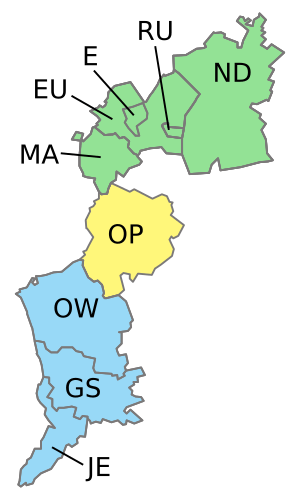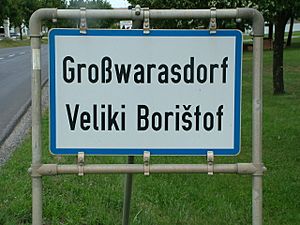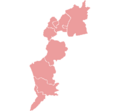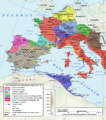Burgenland facts for kids
Quick facts for kids
Burgenland
Gradišće Őrvidék |
|||
|---|---|---|---|
|
|||
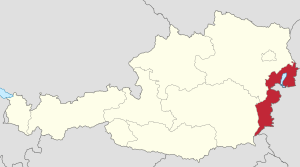 |
|||
| Country | |||
| Capital | Eisenstadt | ||
| Area | |||
| • Total | 3,961.80 km2 (1,529.66 sq mi) | ||
| Population
(1 January 2016)
|
|||
| • Total | 291,023 | ||
| • Density | 73.45727/km2 (190.2534/sq mi) | ||
| Time zone | UTC+1 (CET) | ||
| • Summer (DST) | UTC+2 (CEST) | ||
| ISO 3166 code | AT-1 | ||
| NUTS Region | AT1 | ||
| Votes in Bundesrat | 3 (of 62) | ||
| Website | www.burgenland.at | ||
Burgenland is one of the nine states in Austria. It's the newest state, joining Austria in 1921 after World War I. The name "Burgenland" means "Land of Castles." It was first called "Vierburgenland" (Land of Four Castles) in 1919. This name came from four old Hungarian counties. When one of these areas went to Czechoslovakia, the "Vier" (four) was dropped. The name was officially adopted in 1922.
Contents
Discovering Burgenland's Geography
Burgenland covers an area of about 3,962 square kilometers. It is divided into three main parts. These parts are called Nordburgenland, Mittelburgenland, and Südburgenland.
Burgenland's Three Regions
- Nordburgenland (Northern Burgenland) includes areas like Eisenstadt and Neusiedl am See.
- Mittelburgenland (Middle Burgenland) mainly covers Oberpullendorf.
- Südburgenland (Southern Burgenland) includes Güssing and Jennersdorf.
Sometimes, Mittelburgenland is considered part of Southern Burgenland.
Highest and Lowest Points
The highest point in Burgenland is a mountain called the Geschriebenstein, which is 884 meters tall. The lowest point is near Apetlon, at just 114 meters above sea level. This makes Burgenland quite diverse in its landscape.
Important Waterways
Burgenland shares a large lake, the Neusiedler See, with Hungary. This lake is very important for the region. Other important rivers flowing through Burgenland include the Leitha, Pulka, and Raab.
People and Languages of Burgenland
Burgenland is home to different groups of people. Besides the majority German speakers, there are also Croatian and Hungarian communities.
Minority Languages Spoken
- German is spoken by about 82.9% of the people.
- Burgenland Croatian is spoken by about 10.4%. This language is an old dialect from the 16th century. It is different from the standard Croatian spoken today.
- Hungarian is spoken by about 2.4% of the population.
In the past, there were also Roma and Jewish communities in Burgenland. Sadly, these groups faced very difficult times during the Nazi era.
Burgenland's Fascinating History
Burgenland has a long and interesting history. Its location made it an important border area for centuries.
Early History and Borders
In 1043, a peace treaty set the western border of the Kingdom of Hungary. This border followed rivers like the Leitha and Lafnitz. The area that is now Burgenland became a border zone for Hungary. Most people living here were of Germanic origin. People also moved here from neighboring Austria during the Middle Ages.
Under Habsburg Rule
During the time when the Ottoman Empire occupied parts of Hungary, some areas of today's Burgenland remained under Habsburg rule. The Habsburgs were a powerful European family. After the Austro-Hungarian Empire was formed in 1867, Burgenland was part of the Hungarian side.
Becoming Part of Austria
Because about 74% of the people in the area were German speakers, Burgenland joined the new Republic of Austria. This happened after World War I. In the years leading up to World War II, many people from Burgenland moved to the United States. Some even say that Chicago became a large "Burgenland town" because so many people from the region moved there.
World War II and Beyond
During the Nazi occupation, Burgenland was split up and became part of other Austrian regions. During this time, Jewish people, Roma, and Sinti people faced severe persecution. There was even a camp for Roma and Sinti people in the area.
After World War II, Burgenland was in the Soviet occupation zone. After Austria became fully independent again, Burgenland had a long border with communist countries in Eastern Europe. This made its economic growth very slow for a while. However, after Austria joined the European Union, the economy of Burgenland started to grow much faster.
Burgenland's Government and Leaders
Burgenland has its own government, just like other states in Austria.
How Burgenland is Governed
The state's assembly, called the Landtag, has 36 seats. The government of Burgenland is made up of two main political parties. These are the Social Democratic Party (SPÖ) and the Austrian People's Party (ÖVP). In 2003, Burgenland lowered the voting age for regional elections to 16. This means young people can vote earlier here.
Past Governors of Burgenland
Burgenland has had many governors, known as Landeshauptleute, over the years. Here are some of them:
- Robert Davy (1921–1922)
- Alfred Rausnitz (1922–1923)
- Alfred Walheim (1923–1924)
- Josef Rauhofer (1924–1928)
- Johann Thullner (1929–1930)
- Anton Schreiner (1930–1931)
- Alfred Walheim (1931–1934)
- Hans Sylvester (1934–1938)
- Ludwig Leser (1945–1946)
- Lorenz Karall (1946–1956)
- Johann Wagner (1956–1961)
- Josef Lentsch (1961–1964)
- Hans Bögl (1964–1966)
- Theodor Kery (1966–1987)
- Johann Sipötz (1987–1991)
- Karl Stix (1991–2000)
- Hans Niessl (since 2000)
Fun Things to Do in Burgenland
Burgenland is a great place for tourists! It has beautiful nature and fun events.
Top Attractions
- The Neusiedler See is a huge lake and a major attraction. It's perfect for water sports and relaxing.
- There are several hot springs where you can swim and relax. These include Lutzmannsburg, Stegersbach, and Bad Tatzmannsdorf.
- Burgenland also has over 500 kilometers of bicycle tracks. This makes it a fantastic place for cycling adventures.
Summer Festivals and Events
Many exciting events happen in Burgenland during the summer:
- The Seefestspiele Mörbisch is an operetta festival. It takes place on a stage right on the lakeshore.
- The St. Margarethen Opera Festival is held in different venues around the town.
- Burgspiele Güssing is a theatre festival held at a castle.
- The Jennersdorf summer festival offers various fun activities.
- Several music festivals are held in Wiesen, bringing different sounds to the region.
Burgenland · Carinthia · Lower Austria · Salzburg(erland) · Styria · Tyrol · Upper Austria · Vienna · Vorarlberg
Images for kids
See also
 In Spanish: Burgenland para niños
In Spanish: Burgenland para niños




